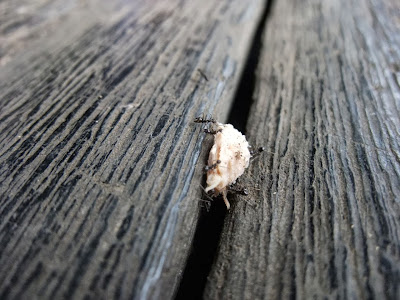We just came back from a week's holiday in the town of Rabaul. That's on the island of New Britain, just over an hour and a half flying east of Lae.
Rabaul is one of the biggest tourist hot-spots in all of PNG, and for good reason. It is a one-of-a-kind place. Here are a few things we enjoyed seeing in Rabaul to give you just a little glimpse...
 |
| A map of the Rabaul area, on the wall of Japanese General Yamamoto's bunker. |
Awesome landscapes
Rabaul is located in a volcanic caldera. Tectonic plates meet, the ground moves, and from time to time eruptions happen. The most recent significant eruption was that of Mt. Tavurvur in 1994 – it destroyed half the town of Rabaul, and is still quite active. There are several other volcanoes in the area that aren't quite so active. It all makes for a fascinating landscape. One cannot but stand in awe of the power of God in a volcano – power that can obliterate great works of human achievement as easily as a dishcloth can obliterate a hundred ants scurrying about around something sweet on the countertop.
 |
A view over Simpson Harbour and the Rabaul caldera, from the Rabaul
Vulcanology Observatory. |
 |
| The 688-metre-high peak of Mt. Kombiu, once an active volcano. |
 |
| Tavurvur, viewed from Mt. Kombiu. |
 |
| Mt. Turangunan, Mt. Tavurvur, and Matupit Island (the green peninsula on the right) |
 |
A sense of the destruction caused by Tavurvur – ash about a metre high,
excavated on one side of the wall, left on the other. |
 |
This area was once a beautiful town, but everything crumbled
under the weight of the ash. |
 |
The continual slow deposition of ash around Rabaul makes the tin roofs
rust rather quickly. Here you can also see the mounds of ash along
one of the main roads. |
The volcanoes and their effects are not the only natural attraction. Rabaul is a coastal town, and nearby are some beautiful coral reefs full of colourful fish. I also caught an exciting glimpse of what must have been a dolphin (or something just as big) jumping out of the water a few hundred metres off shore.
 |
| Someone from a nearby village fishing from a canoe. |
 |
This someone wasn't fast enough and caught
only a starfish. |
May the glory of the LORD endure forever; may the LORD rejoice in his works, who looks on the earth and it trembles, who touches the mountains and they smoke! I will sing to the LORD as long as I live; I will sing praise to my God while I have being. May my meditation be pleasing to him, for I rejoice in the LORD. (Psalm 104:31–34, ESV)
Traditional culture
The Rabaul area is home to the Tolai people. They came over from New Ireland (the large island just to the north), probably a few centuries ago, driving the former inhabitants, the Baining south into the mountains.
The Baining, who have been described as "the dullest culture on earth," do have a dance that they perform from time to time. A cruise ship anchored in Rabaul harbour while we were there, and so they put on a performance of the fire dance. In this dance, masked men dance around the fire, and go through the fire, kicking up the coals with their bare feet.
The currency of PNG today is the kina, which is composed of 100 toea. These two words both refer to shells, which was the traditional currency in parts of PNG, Rabaul included. People would store their shell money on rings. Below is a picture of a very large ring (3 metres in diameter), hanging from the ceiling of the Phoenix Room restaurant.
The Rabaul area was one of the first areas of what is now PNG to have contact with white people – whalers, traders, and missionaries.
Missions and Christians
In the 1870s, missionaries started coming to the Rabaul area – first the Methodists, and then the Roman Catholics. That these were the first two groups in the area is still evident by the fact that the United Church and the Roman Catholic Church are still the largest churches in the area.
Our family went for a long walk one day to Matupit Island (thanks to Tavurvur's ash piling up over the years, Matupit is now connected to the mainland, but it is still called an island). There we found what we think is a memorial to the first landing of the Methodist missionaries in the area (but we're not entirely sure if the person we asked to help us find it knew what we were looking for). Anyway, here's what we found:
In a village outside of Rabaul, an interesting story is told in stained glass in the chapel of the Roman Catholic Basilica of Rakunai. During World War II, the Japanese forbade Christian worship. Catechist Peter Torot resisted them, and taught and baptized anyway. Locals informed the Japanese, and he was put to death by lethal injection. Below, just two of the images that tell the story:
War history
PNG was very much involved in WWII, as a battleground between the Japanese and the Allies. The Japanese established a strong base at Rabaul, and there are still many reminders of their presence. Those were horrible times, and a few pictures cannot do justice to that.
 |
| One of many tunnels carved into the hills. |
 |
| General Yamamato's bunker. |
 |
A Japanese Betty Bomber, bombed by the allies while sitting
on the tarmac (this had to be excavated out of volcanic ash, as
the old airport was very close to Tavurvur). |
 |
| Japanese peace memorial. |
 |
| Allies' memorial cenotaph. |
Well, there you have it... a few snapshots of Rabaul. Well worth a visit, for all kinds of reasons!





















































